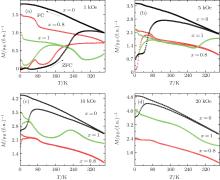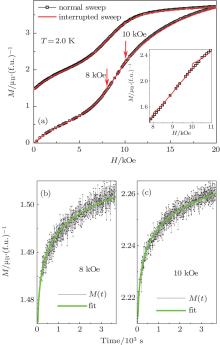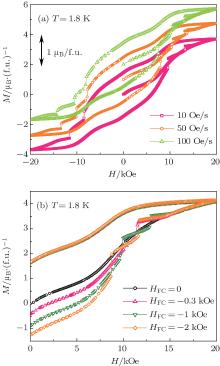†Corresponding author. E-mail: xia9020@hust.edu.cn
*Project supported by the National Natural Science Foundation of China (Grant No. 11104091) and the Funds from Provincial Key Laboratory of Information Materials, Guilin University of Electronic Technology, Guangxi Zhuang Autonomous Region, China (Grant No. 1210908-05-K).
We investigate the low-temperature magnetic properties of intermetallic compounds Tb1 − xPr x(Fe0.4Co0.6)1.88C0.05 ( x = 0, 0.8, and 1) by detailed magnetization measurements. Obvious temperature- and field-induced irreversibilities suggest the coexistence of multiple magnetic phases. Sharp magnetization jumps across the antiferromagnetic to ferromagnetic transition are observed only in the Pr-containing samples, indicating that the behavior of the avalanche-like growth of ferromagnetic clusters is mainly related to the light lanthanide Pr ions. In addition, the time relaxation, field sweep rate, and cooling field dependence of magnetization jumps in the sample with x = 1 are consistent with those in the martensitic scenario.
In rare earth transition metal intermetallics, the nature of the interaction between the 3d magnetism of the transition metal and the localized 4f magnetism of the rare earth ions is of primary interest. Among them, doped CeFe2 compounds exhibit intriguing magnetization jumps across the antiferromagnetic (AFM) to ferromagnetic (FM) transition, which shows characteristics resembling those in the martensitic scenario.[1, 2] A similar jump behavior has been reported in many kinds of materials, such as intermetallic germanide Gd5Ge4, [3, 4] mixed-valent manganite Pr0.6Ca0.4MnO3, [3, 5, 6] multiferroic Y2CoMnO6, [7] cubic NaZn13-type polycrystalline Pr0.2La0.8Fe11.4Al1.6, [8] mixed-spin oxide FeTiO3-Fe2O3, [9, 10] and some other materials.[11, 12] Among the family of the cubic C15 MgCu2-type Laves phase compounds RFe2 (R = rare earth), Ouyang et al. studied the mixing effects of light and heavy rare earths in Nd1 − xTbxCo2.[13] Besides, the magnetic and magnetostrictive properties of PrxNd1 − xFe1.9 alloy[14] and some bulk MgCu2-type rare-earth iron compounds[15] were studied. Previously, scientists have studied the structural, magnetic, and magnetostrictive properties of the quasi-quaternary intermetallic compounds (Tb0.2Pr0.8)(Fe0.4Co0.6)1.93 − xBx, [16] (Tb0.2Pr0.8)(Fe0.4Co0.6)1.93 − xCx, [17] and Tb1 − xPrx(Fe0.4Co0.55 B0.05)1.93, [18] in which a small amount of doped C/B which occupies preferentially the interstitial sites can effectively inhibit the formation of the 1:3 PuNi3-type phase.
In the present work, we mainly investigate the low-temperature magnetic properties of intermetallic compounds Tb1 − xPrx(Fe0.4Co0.6)1.88C0.05 (x = 0, 0.8, and 1) by detailed susceptibility measurements, in order to figure out the influence of the spin structure in R-site on the meta-magnetic transition and the observed magnetization jump behavior similar to that of doped CeFe2 compound[12] in our Pr-containing samples. Furthermore, the time relaxation, field sweep rate, and cooling field dependence of sharp jumps of Pr(Fe0.4Co0.6)1.88C0.05 compound are investigated by specified measurement protocols, which shows the characteristics of the martensitic scenario.
Polycrystalline samples of Tb1 − xPrx(Fe0.4Co0.6)1.88C0.05 (x = 0, 0.8, and 1) were synthesized by conventional arc melting in high-purity argon (10− 3 Pa). The purity of the constituents was 99.9% for Tb and C, 99.99% for Fe and 99.8% for Co, respectively. The ingots were homogenized at 700 ° C (for the sample of x = 0.8) and 900 ° C (for the samples of x = 0 and 1) for seven days in high-purity argon atmosphere, which were then quenched in ice water. X-ray diffraction (XRD, Philips X’ pert pro) data were measured at room temperature with Cu Kα radiation (1.54 Å ). Magnetization (M) data were acquired using a vibrating sample magnetometer on a commercial superconducting quantum interference device (SQUID-VSM Quantum Design, Inc.). Temperature (T) dependences of the zero-field cooled (ZFC) and field cooled (FC) magnetization, M(T), were measured between 1.8 K and 380 K at selected magnetic fields (H). The ZFC isothermal magnetization was measured after cooling the sample from 380 K to selected temperatures.
The x-ray diffraction patterns of powdered Tb1 − xPrx (Fe0.4Co0.6)1.88C0.05 (x = 0, 0.8, and 1) samples at room temperature are shown in Fig. 1. From the results it can be seen clearly that Tb0.2Pr0.8(Fe0.4Co0.6)1.88C0.05 consists of single MgCu2-type Laves phase (space group 
 | Fig. 1. The XRD patterns of powdered Tb1 − xPrx(Fe0.4Co0.6)1.88C0.05 (x = 0, 0.8, and 1) compounds at room temperature. |
Temperature dependences of magnetization of Tb1 − xPrx (Fe0.4Co0.6)1.88C0.05 (x = 0, 0.8, and 1) compounds measured in ZFC and FC modes under various magnetic fields are shown in Fig. 2. For the sample with x = 0 as shown in Fig. 2(a), an obvious anomaly emerges at the ZFC branch when 







In order to further investigate the effects of the Tb ions and/or the Pr ions on the magnetic properties of Tb1 − xPrx(Fe0.4Co0.6)1.88C0.05 compounds, the five-quadrant M(H) isotherms at 1.8 K are shown in Figs. 3(a)– 3(c). To take into consideration the effects of external variables, all of the measurements are carried out based on the specified protocol; that is, the samples are demagnetized at 380 K and then zero-field cooled down to 1.8 K with dT/dt = 10 K/min, and the measurements are performed at a magnetic field sweep rate of 50 Oe/s. The number and located branches of magnetization jumps observed across the AFM– FM transitions for the samples with x = 0.8 [Fig. 3(a)] and x = 1 [Fig. 3(b)] are exactly the same. However, the former has a higher critical magnetic field of each jump, and the curves between adjacent jumps are inclined with respect to the H-axis, which is different from the H-axis-parallel plateaus of the latter. In clear contrast, the M(H) isotherm of the sample with x = 0 [Fig. 1(a)] shows a smooth magnetic transition behavior with no abrupt change in magnetization. The data presented in Figs. 3(a)– 3(c) indicate that the occurrence of magnetization jump is strongly related to the light lanthanide Pr ions rather than the heavy Tb ions.
In order to analyze the saturated (MS) and remanent (Mr) magnetization of Tb1 − xPrx(Fe0.4Co0.6)1.88C0.05 compounds, we expand the external magnetic field to ± 70 kOe in the M(H) measurement as shown in Fig. 3(d). Unlike the zero remanent magnetization in doped CeFe2 compounds, [1, 2] the value of Mr is high in our samples, which can be used to classify the materials into type-1 and type-2 materials, as proposed in Ref. [7]. The values of MS and Mr are listed in Table 1, from which it can be obtained that the mixed rare-earth Tb0.2Pr0.8(Fe0.4Co0.6)1.88C0.05 compound has the largest MS in all of the three samples. This phenomenon can be interpreted as follows. i) For Tb(Fe0.4Co0.6)1.88C0.05, the 4f electrons of the heavy lanthanide Tb ions couple antiferromagnetically with the 3d electrons of the transition metal Fe(Co) ions, [22– 25] and the Tb– Tb magnetic moments couple ferromagnetically.[26] ii) For Pr(Fe0.4Co0.6)1.88C0.05, parallel alignments are formed between the light Pr 4f electrons and Fe(Co) 3d electrons, as well as the magnetic couplings between spins of Pr ions.[26] iii) For mixed rare-earth compound Tb0.2Pr0.8(Fe0.4Co0.6)1.88C0.05, besides the AFM/FM couplings between Tb/Pr 4f electrons and Fe(Co) 3d electrons, there exist anti-parallel alignments between spins of Tb ions and those of Pr ions. This also explains that the samples (x = 0 and 1) containing single rare earth element correspond to single magnetic transition, relative to double transitions in the mixed rare earths sample (x = 0.8), as observed in Fig. 2. In addition, the ratio of MS/Mr (= 39.9%) for the sample with x = 1 is minimum while that for the sample with x = 0.8 (MS/Mr = 88.3%) is maximum.
| Table 1. Values of MS and Mr of Tb1 − xPrx(Fe0.4Co0.6)1.88C0.05 compounds (x = 0, 0.8 and 1). |
The abrupt changes in magnetization can be ascribed to the avalanche-like growth of FM clusters in the vicinity of the critical magnetic field as observed in doped CeFe2 compounds which show martensitic scenario.[1, 2] In this regard, detailed magnetization measurements are performed in Pr(Fe0.4Co0.6)1.88C0.05 sample, including the temperature, relaxation time, field sweep rate and cooling field dependence of magnetization jumps, in order to examine the intrinsic characteristics of martensitic transition in this sample.
Figure 4 shows the influence of temperature on the jumps observed in the M(H) isotherm. As shown in Fig. 4(a), at stage 1 (0 → 20 kOe), when T = 1.8 K and H < 5 kOe, the slope of the data is apparently greater than that observed in the sample with x = 0.8 [Fig. 3(a)], suggesting that the AFM ground state of Pr(Fe0.4Co0.6)1.88C0.05 is less stable than that of the sample with x = 0.8. With increasing magnetic field, the slope becomes bigger and an abrupt jump in magnetization is observed at H = 13 kOe. At stage 2 (20 kOe → 0 kOe), a smooth FM– AFM transition is observed, in clear contrast to the almost constant FM content of the sample with x = 0.8 at the same M(H) branch. And three magnetization jumps are observed during the reorientation of the FM moments at stage 3 (0 → − 20 kOe). Stage 4/5 is the reverse process of stage 2/3. By comparison with the case of Tb0.2Pr0.8(Fe0.4Co0.6)1.88C0.05, the number of jumps decreases more rapidly with the increase of temperature, indicating that the intermediate magnetic states in Pr(Fe0.4Co0.6)1.88C0.05 are more sensitive to thermal fluctuation.
 | Fig. 4. M(H) isotherms of Pr(Fe0.4Co0.6)1.88C0.05 at (a) T = 1.8 K, (b) 2.0 K, (c) 2.2 K, and (d) 2.4 K. |
It can be demonstrated from Fig. 5(a) that the measurement protocol can also induce the appearance of abrupt magnetization jumps. At T = 2 K, the acquired data show no jump behavior in the normal sweep. Meanwhile, in the interrupted sweep, magnetic fields of 8 kOe and 10 kOe are maintained for 3000 s, giving rise to additional magnetization jumps. In the maintaining time, magnetization data are recorded as a function of time, as shown in Figs. 5(b) and 5(c). Both of the M(T) curves can be well fitted by the stretched exponential function M(t) = M0 exp[– (t/τ )β ], [7, 27– 30] where τ is the relaxation time of the magnetic spin, and β is the stretching exponent (0 < β < 1). The magnetic relaxation behavior observed from the M(t) curves indicates that the magnetic state at a low temperature resembles a glassy state, [3, 6, 27] and also suggests that the magnetization jumps are dependent on the dynamics of the martensitic strain distribution.[2]
From Fig. 6(a) it is clearly seen that the magnetic field sweep rate significantly affects the number and critical field of magnetization jump, which is reminiscent of the martensitic scenario in this compound.[2– 4, 6, 7] In a metamagnetic system, the critical field of magnetization jump is generally related to the field cooling process. Figure 6(b) shows the initial and second branches of the M(H) isotherms of Pr(Fe0.4Co0.6)1.88C0.05 at T = 1.8 K under negative cooling fields (– HFC); however, no jump behavior is observed under + HFC (data are not shown). This phenomenon can be well explained by using the AFM– FM interface model proposed in Ref. [7] when discussing the effect of cooling fields on the jump behavior in multiferroic Y2CoMnO6. When the cooling field is negative, the induced FM content aligns oppositely to the external magnetic field, while the spins on the AFM side due to the interface coupling align along the external magnetic field, promoting the magnetic jump, [4, 7] making the elastic energy decrease. With the increasing strength of | HFC| , the number of magnetization jumps increase, meanwhile the corresponding critical fields shift to a lower field region. The time relaxation, field sweep rate, and cooling field dependence of magnetization jumps in Pr(Fe0.4Co0.6)1.88C0.05 compound show the behaviors similar to those observed in doped CeFe2[1, 2] and multiferroic Y2CoMnO6, [7] suggesting the existence of the martensitic scenario in these materials.
In this work, we investigated the magnetic properties of intermetallic Tb1 − xPrx(Fe0.4Co0.6)1.88C0.05 compounds (x = 0, 0.8 and 1). Only in the Pr-containing samples (x = 0.8 and 1) were sharp magnetization jumps observed across the AFM– FM transition associated with the avalanche-like growth of FM clusters. The experimental results suggest that the jumps accompanied by the intermediate metastable states are determined by the light lanthanide Pr ions. Meanwhile, the step-like behavior can also be observed in the interrupted sweep condition or under the negative cooling field. In addition, the time, field sweep rate, and cooling field dependence of jump behavior confirm the martensitic scenario in the Pr(Fe0.4Co0.6)1.88C0.05 compound.
| 1 |
|
| 2 |
|
| 3 |
|
| 4 |
|
| 5 |
|
| 6 |
|
| 7 |
|
| 8 |
|
| 9 |
|
| 10 |
|
| 11 |
|
| 12 |
|
| 13 |
|
| 14 |
|
| 15 |
|
| 16 |
|
| 17 |
|
| 18 |
|
| 19 |
|
| 20 |
|
| 21 |
|
| 22 |
|
| 23 |
|
| 24 |
|
| 25 |
|
| 26 |
|
| 27 |
|
| 28 |
|
| 29 |
|
| 30 |
|






